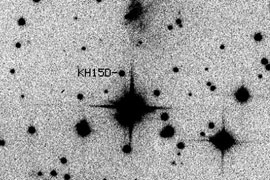NASA Awards Wesleyan Astronomer Major Grant
  |
| Astronomy Professor William Herbst studies the star, KH 15D. Pictured are images of KH 15D out of eclipse (left) and in eclipse (right) as taken from Wesleyan’s observatory. |
| Posted 03/31/05 |
| It’s 3 million years old and 2,400 light years away, but a distant star discovered by Wesleyan researchers has given insight into how our solar system may have formed. NASA wants to know more, and has given William Herbst almost a quarter of a million dollars to keep looking. This month NASA (the National Aeronautics and Space Administration) awarded Wesleyan Professor of Astronomy William Herbst a $216,000 grant to continue his studies of the star, KH 15D, and other emerging stars and their possible link to the creation of our solar system. The grant for Herbst’s proposal titled “Synoptic Studies of T Tauri Stars in Nearby Clusters and Associations” will span three years. It was approved by NASA’s Origins of Solar Systems Program and is one of only 39 proposals of the 94 submitted that received funding. “NASA is particularly interested in this work because they want to find planets that may support life,” says Herbst, the Van Vleck Professor of Astronomy, chair of the Astronomy Department and director of the Van Vleck Observatory. “As far as we know, life can only get started on a planet. Understanding how these types of planets form can help us pinpoint where they may exist and when the conditions for the creation of life first occur.” Three years ago, Herbst reported how KH 15D, a star in the constellation Monoceros that he and graduate student Kristin Kearns discovered, and that physics Ph.D. candidate Catrina Hamilton further helped identify, seemed to displaying the early stages of planet formation. KH 15D was periodically going through “winking” eclipses, determined by Herbst to be he swirling waves of rock and dust clouds typical of early planet formation. The discovery sent excitement through the astronomical community. He continues to study KH 15D and other young stars looking for more clues. “Wesleyan has been recognized as a world leader in monitoring these young stars,” Herbst says proudly. “And we are able to do many of our observations using our own observatory on campus.” Herbst also notes that in the awarding of the grant, the officials at NASA went out of their way to applaud the way undergraduates have been involved in the studies. Specifically, the reports says Herbst “is to be commended for his extensive work in student training, where he has done a first rate job in engaging undergraduates in research and launching them along productive career paths.” “Involving undergraduates in the research is not required for the grant. In fact it’s pretty atypical for this level of research,” Herbst says, then smiles. “But it is what we do here at Wesleyan. I was glad NASA made note of it. It’s a part of our program that we are very proud of.” Related resource: Animation of KH 15D. |
| By David Pesci, director of Media Relations |

